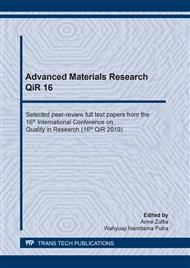p.318
p.324
p.331
p.339
p.348
p.356
p.364
p.375
p.381
Integrity Analysis of a Vessel Subject to Weld Repair and Post-Weld Heat Treatment: Thermal Stress Distribution Using Numerical Approach
Abstract:
Here, we present a numerical approach to analyze the integrity of a vessel that was subject to a weld repair. A Post-Weld Heat Treatment (PWHT) process was implemented to a vessel undergone weld repair due to leakage. Due to the thick wall of the welded bottom head, this welding process must be followed by the PWHT to relieve the residual stress, as well as to improve the material properties. PWHT process was performed by heating the welded area to reach 675 °C temperature. A numerical approach using finite element analysis (FEA) method was performed to analyze the integrity of the vessel. Based on the analysis, the structure is still stable within the applied load. PWHT process does not lead to buckling on the main structure and the load is still lower than the load required for the occurrence of buckling. A sensitivity analysis was also performed with reduced temperatures to 630 °C or reduction of PWHT area width. These changes were found to have negligible effects in reducing the stress and strains in the vessel. After PWHT is completed, the structure is still considered to be safe to be operated, as indicated by its strain that is still below the allowable strain and only relatively small deflection was occurred.
Info:
Periodical:
Pages:
348-355
Citation:
Online since:
July 2020
Keywords:
Price:
Сopyright:
© 2020 Trans Tech Publications Ltd. All Rights Reserved
Share:
Citation:


